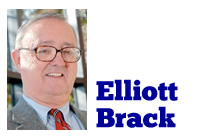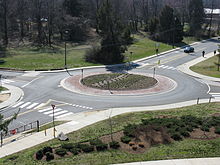By Elliott Brack, editor and publisher | Americans anticipating a British driving vacation face two problems: driving on the “wrong” (left) side of the road….and British roundabouts. Britain has more roundabouts as a proportion of roads than any other country. Many get confused at negotiating the roundabout, while driving in a left-side steering car gets a little more comfortable after a while.
 Americans vacationing in France face only the roundabout problem, as the French drive on the “right” side of the road. Yet there are more roundabouts in France (30,000 as of 2008) than in any other nation.
Americans vacationing in France face only the roundabout problem, as the French drive on the “right” side of the road. Yet there are more roundabouts in France (30,000 as of 2008) than in any other nation.
After lunch one Sunday at the intersection of Brown’s Bridge Road and Georgia Highway 400 in Forsyth County, traffic north on Route 400 was backed up a mile. We got to thinking: instead of a long, long halt of the Route 400 traffic because of the traffic signals, what would a roundabout do at this location?
According to experts, it would probably move all traffic through that location faster, since autos would merely slow, not normally stopping, maneuvering through a roundabout. When negotiating a roundabout, most of the vehicles never actually halt for the lights, as vehicles lining-up at intersections which have traffic lights. Drivers do not have to wait for a signal to change.
Engineers favor roundabouts. They say it cuts congestion, reduces collisions, and most importantly, reduces deaths, which fall 78 percent, at roundabouts! That’s enormous, and easily over the long run pay for changing intersections to roundabouts.
This produces several benefits:
- Engine pollution (including noise) is reduced since there is less engine idling.
- By merging slowly, there is no stopping of vehicles from any direction. If a vehicle needs to giveaway to a car in the circle, entering traffic slows—not stops.
- Traffic enters from one direction, instead of three directions, simplifying operations.
- T-bone crashes (cars hitting another broadside) is eliminated. (This is a major benefit of a roundabout.)
- Accident severity is drastically reduced.
 Years ago, when Brett Harrell was Snellville’s mayor, he proposed a roundabout at the intersection of U.S. Highway 78 and Georgia Highway 124 (Scenic Highway.) He was hooted down. But now that idea that Brett (now a state representative) once floated, is looking better and better.
Years ago, when Brett Harrell was Snellville’s mayor, he proposed a roundabout at the intersection of U.S. Highway 78 and Georgia Highway 124 (Scenic Highway.) He was hooted down. But now that idea that Brett (now a state representative) once floated, is looking better and better.
Some intersections would require more right-of-way purchase for the intersection. But many intersections, like the one on Brown’s Bridge Road at Georgia 400, probably could be built without additional land purchases.
On another note, there would be no need to spend money on the traffic light installation and the high cost of signal maintenance of the electricity for those signals. Traffic lights at major intersections can cost up to $200,000.
While roundabouts are more popular in Europe, Americans have never embraced the plan. Maybe some of that is because Out West, many roads have a geographic basis, running north-south, or east-west. And with some roads more popular than others, government officials simply installed a STOP sign on the less-used roads. That in effect may have been the reason Americans never thought about roundabouts. (No idea why the Eastern seaboard never embraced roundabouts.)
So when Americans started driving trips to Europe, seeing those roundabouts really confuses them.
By the way, there are a few roundabouts in Gwinnett, and a few more coming. Let’s welcome them; they may be the way of the future, making intersections safer, and perhaps even faster, too.
We think roundabouts are worthy of the future of Gwinnett, and today add “Uses of more roundabouts at heavy traffic intersections” to our List of Continuing Objectives (see entire list at bottom right of front page.)









Follow Us